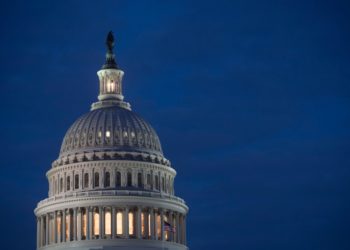Toxic man-made chemicals known as Per- and polyfluoroalkyl substances (PFAS) are widely used in firefighting foam as well as several kinds of household products such as waxes, nonstick products, and paints, but there are currently no regulatory measures to keep them from contaminating sources of food and drinking water.
In 2019, PFAS have been the subject of intensified scrutiny from both Congress and the Environmental Protection Agency (EPA). The substances are highly persistent both in the environment and in the human body, according to the EPA, and have the potential to accumulate over time.
As the chemicals build up, they can cause adverse health effects such as cancer, low infant birth weights, and thyroid hormone disruption. But renewed efforts to regulate the chemicals have led companies like 3M and Exxon Mobil to invest heavily in lobbying against PFAS related legislation.
The chemicals have been detected in food and drinking water, especially near military bases and other areas where firefighting foam is used or the chemicals are made. According to a recent report from The Intercept, 3M knew about PFAS contamination of food as early as 2001.
No Regulations
Between 2017 and 2018, members of the 115th U.S. Congress introduced nine bills that would have imposed regulations on PFAS to varying extents. Comparatively, 34 such bills have been introduced since the 116th Congress took office in January of this year.
“There’s not much in the form of current regulation,” Scott Faber, the Senior Vice President for Government Affairs at Environmental Working Group, told The Globe Post.
“We don’t know who is discharging PFAS into the environment and they’re not required to report their discharges. We don’t know how extensive PFAS contamination is because we don’t routinely monitor for it. There are no limits on the discharge of PFAS.”
Faber added that there are currently no requirements for the cleanup of PFAS, filtering of the chemicals out of tap water, or disposal of PFAS waste.
“There’s so little regulation of PFAS in the United States that other countries are sending us their PFAS waste to dispose of it,” Faber said. “I suppose if you could put it in a rocket ship and blast it into the sun, they would, but they don’t have to because they can just ship it here.”
Meanwhile, the EPA released its Comprehensive Nationwide PFAS Action Plan in February, but proponents of PFAS regulation like Faber remain skeptical that the action plan will ever culminate in any actionable policy.
“There’s nothing in that document that would actually regulate PFAS discharges or require drinking water utilities to clean up PFAS pollution and hold PFAS polluters accountable for the mess they’ve created,” Faber said.
He added that the only tangible provision in the EPA’s plan is that they will make a regulatory determination under the Safe Drinking Water Act on two of the 4,700 PFAS (PFOA and PFOS) by the end of the year.
So when we see maps of #PFAS detection and Michigan is lit up and other states, like Ohio, isn’t does that mean there’s no contamination in Ohio? Nope, said attorney Richard Head at @ngwatweets conference. It just means Ohio isn’t regulating it yet, but it’s there. pic.twitter.com/Y1tOaJbTP4
— Alex Ebert (@Alex__Ebert) June 20, 2019
Special Interests Push Back
On June 19, the Senate Environment and Public Works Committee unanimously approved an amendment to the National Defense Authorization Act sponsored by Senators Shelly Moore Capito of West Virginia and Tom Carper of Delaware.
The amendment has a “very comprehensive approach” to PFAS, according to former EPA official Elizabeth Southerland, who resigned from the administration in 2017 amid disagreements with former EPA Administrator Scott Pruitt.
The amendment would require drinking water utilities to test for PFAS, require manufacturers to report discharges of the chemicals into the air and water, and add PFAS to a list of contaminants tracked by the U.S. Geological Survey according to the Environmental Working Group.
“If [the amendment] passes, it would be the most comprehensive approach to a new emerging contaminant, certainly that I’ve ever seen,” Southerland told The Globe Post. “I just don’t know if the amendment will survive the vote in the full Senate.”
The Environmental Working Group provided The Globe Post with a list of 30 companies that have filed lobbying disclosures on PFAS related legislation. The list includes oil companies like Shell and Exxon Mobil as well as chemical companies like 3M and the Dow Chemical Company. Also included are companies from various other industries including air conditioning, furniture, wood finishing, and defense.
“3M and [Dow Chemichal] have paid out all kinds of money in toxic tort litigation,” Southerland said. “The courts have ruled that they were responsible for these toxic health effects.”
Faber participated in a June 21 panel discussion on PFAS sponsored by George Mason University which included Jonathan Gledhill, a lobbyist and the president of the Policy Navigation Group. Also on the panel were Tracy Mehan, the Executive Director of Government Affairs for the American Water Works Association and Principal of Beveridge and Diamond PC Steven Jawetz.
At DC #PFAS briefing today:
Me: PFAS is really bad and we need to clean it up
Industry lobbyist A: It's bad, but we're not sure how bad.
Industry lobbyist B: It's bad, but there are other bad things.
Industry lobbyist C: It's bad, but cleaning it up will cost people money.— Scott Faber (@faberfamilyfarm) June 21, 2019
Gledhill and The Policy Navigation group have an extensive history of lobbying on behalf of various interests with a stake in PFAS regulation including Dow Chemical, the Responsible Science Policy Coalition, and the American Water Works Association.
Gledhill cautioned against immediate regulation of PFAS and called scientific evidence of adverse health effects into question. He claimed current research on the chemicals lacks peer review and further study is needed.
“We need to be careful … It doesn’t take long. We can weigh literature very quickly in about a year or so and that’s what we’ve been urging,” Gledhill said. “We should decide what the best available science is … What we’re seeing is people making fast decisions…and they’re not following best practices.”
Faber, however, countered by pointing out that the EPA and the Agency for Toxic Substances and Disease Registry have both already concluded that PFAS are harmful. Faber also expressed concern for those who will continue to drink PFAS contaminated water if the regulatory process is delayed due to further study.
“There’s no question about whether these forever chemicals that build up in our blood and organs and are in our babies when they’re born are causing serious health problems,” Faber said.
“There’s no question that we can get these chemicals out of our water to levels below two parts per trillion. The only question is who pays. Is it the people who pay [Gledhill] to tell you that there are no peer reviews when indeed there are, or is it the rest of us who pay water bills every month?”
More on the Subject
Overlooked Crisis: Drinking Water Contamination Widespread in US























